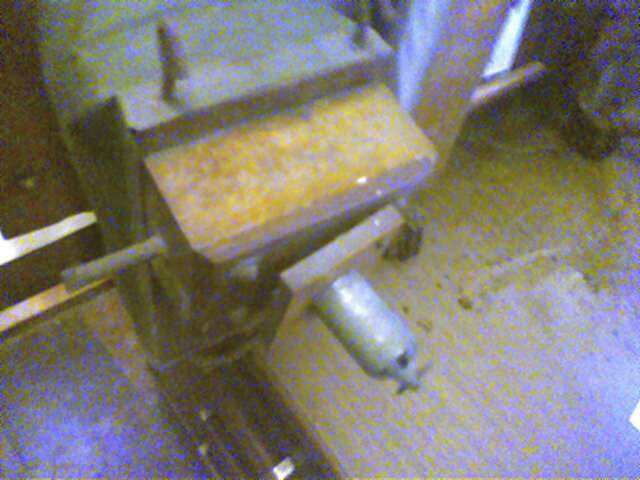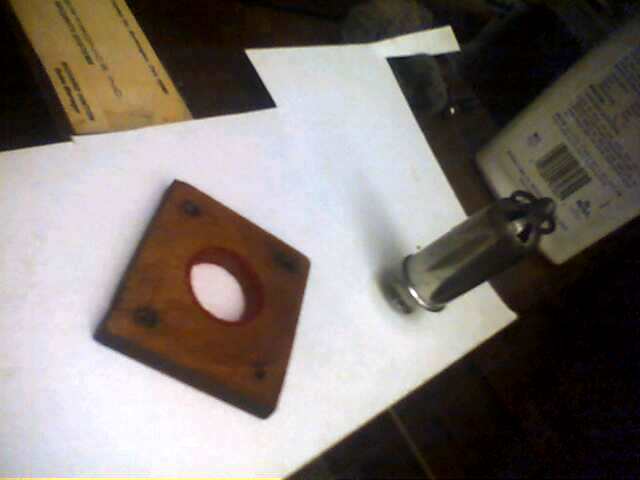Opus # 4049, Style U010
Pipe Ranks
Tibia 97 pipes (?)
Flute 85 pipes (?)
Vox Humana 73 pipes
Viol 73 pipes
Tuned Percussion
Marimba/Harp
49 bars
Chimes
5 tubes
|
PEDAL ORGAN Bdn 16 Tibia 8 Cello 8 Bass Flute 8 Tibia 4 Flute 4 Bass Drum Cymbal Timpani Acc/Ped Coupler Accompaniment Double Touch Tibia 8 Tibia 4 ACCOMPANIMENT Harp Marimba Snare Drum Tambourine Castanets Bdn 16 Tibia 8 Viol 8 Quint 8 (synth) Flute 8 Vox Hum 8 Tibia 4 Salic 4 Flute 4 Vox 4 Picc 2 |
SOLO Harp Tibia 16 TC ConViol 16 TC Bourdon 16 Vox Hum 16 TC Tibia 8 Orch Oboe 8 (synth) Viol 8 Quint 8 (synth) Flute 8 Vox Hum 8 Tibia 4 Viol 4 Flute 4 Vox 4 Picc 2 General Tremolo OTHER 5 chimes, played from spring loaded stop tabs Non-Tuned Percussions (six toe studs) Siren Bird Whistle Sleigh Bells Castanets Tambourine Indian Drum Swell Pedal Crescendo Pedal |
Photographs
 The Bass Drum and Crash Cymbal action. The large wooden beater is for a single stroke on the Bass Drum; the two small beaters are for the Timpani effect (Bass Drum Roll). |
 The Toy Counter. From
left to right
are visible: Tambourine, Castanets,
Indian Drum, Sleigh Bells, Snare
Drum. Not visible: Siren, Bird Whistle. The Toy Counter. From
left to right
are visible: Tambourine, Castanets,
Indian Drum, Sleigh Bells, Snare
Drum. Not visible: Siren, Bird Whistle. |
 Interior view of the toy counter windchest, pre-restoration. Visible are two brown pillow pneumatics that collapse when current is supplied to the action magnet. When the pneumatic collapses, a valve opens, releasing air that operates a drum, whistle, or other sound effect. Restoration of the chest requires new leather on the pneumatics and new gasket material (white). Also the valve disks will receive new soft leather facings to ensure a tight seal. |
Here the toy counter is re-assembled after restoration of individual components. |
 Close-up view of the
pneumatics that
operate the Harp/Marimba. Close-up view of the
pneumatics that
operate the Harp/Marimba. |
Swell shade pneumatics (bottom) and half of the Harp/Marimba action (top). |
 This is a fixture we built to hold the pneumatics square and parallel while we replaced the leather with new material (white sheepskin). It worked great! |
|
  Two views of the siren. On the
left, what it looked like when it arrived. On the right,
after the siren was polished and the faceplate shellacked. Later I replaced the siren with an identical new one made by the original manufacturer: the Acme Siren Company (really) of England. The white material under
the siren and faceplate is thick blotter paper used for gasket material. Two views of the siren. On the
left, what it looked like when it arrived. On the right,
after the siren was polished and the faceplate shellacked. Later I replaced the siren with an identical new one made by the original manufacturer: the Acme Siren Company (really) of England. The white material under
the siren and faceplate is thick blotter paper used for gasket material. |
 Here is some "inside information!" This photo shows the interior of the main windchest that supplies air to some of the organ pipes. At the bottom of the photo are electromagnets that lift small disks called armatures. This causes the tan leather disks, called pouches, to collapse, pulling down the valve wire and admitting air into the pipes. Rebuilding will require releathering the magnet armatures, removing and replacing old leather pouches, and replacing the red-and-white valve material. Oh yes -- we have to remove and replace the old cotton-covered wiring as well. All in a day's work. |